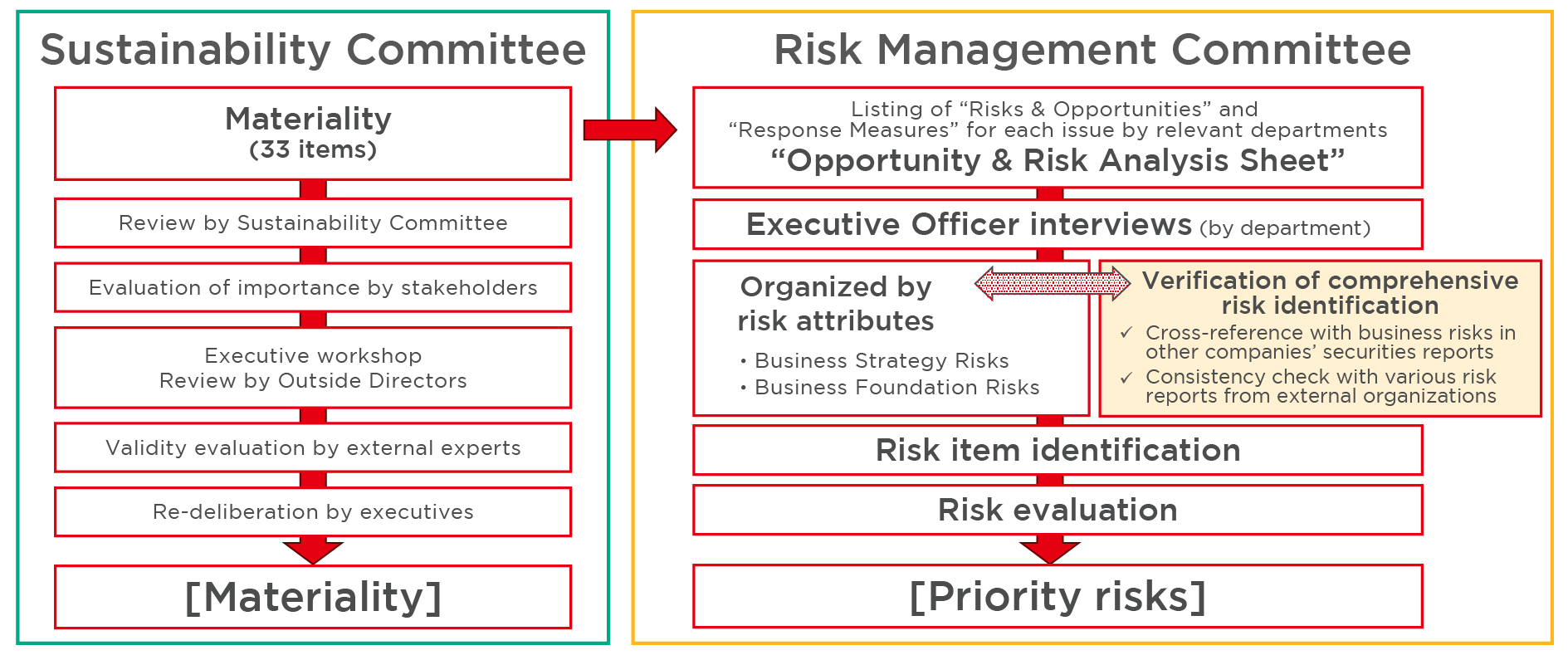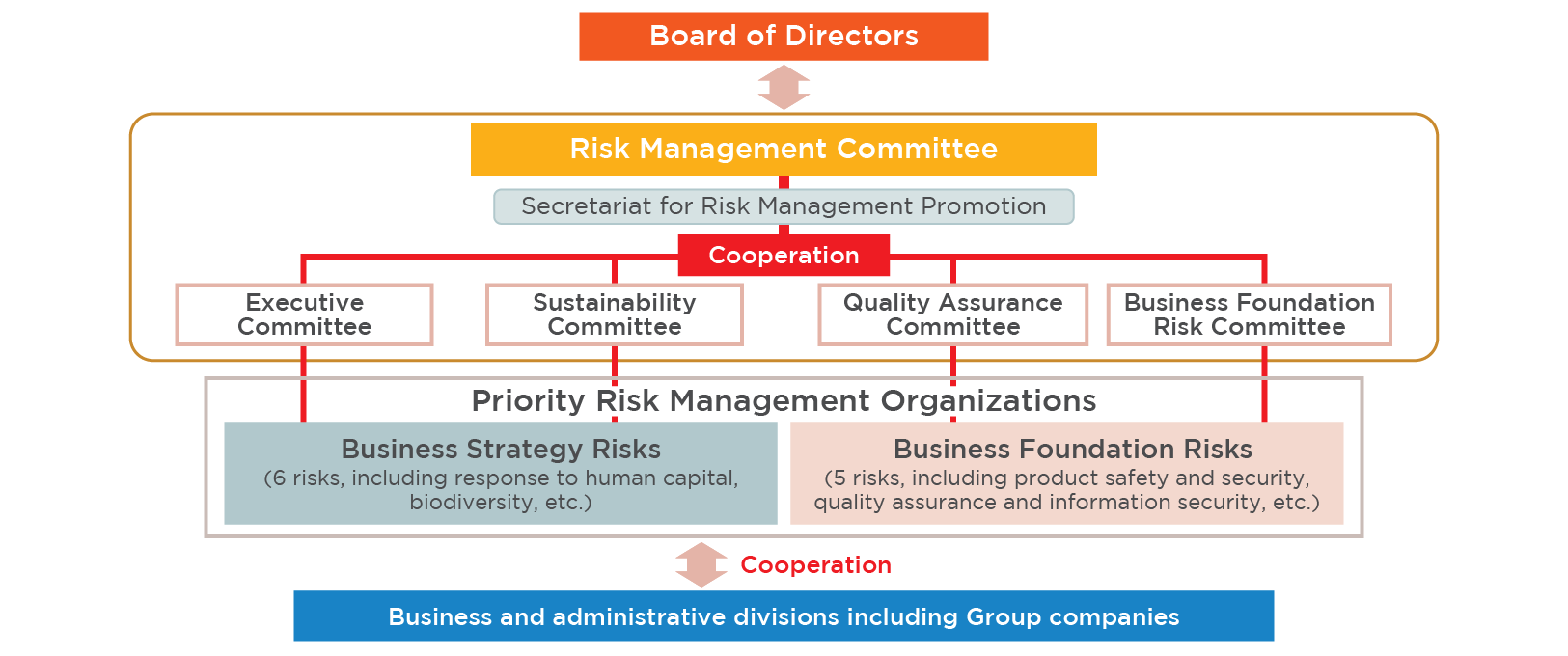Risk Management of the Group
(1) Our Approach to Risk Management
The Company defines "risk" in its "Risk Management Rules" as the uncertainty of events that may affect the continuity of the Company, and risk management as activities to appropriately manage various internal and external risks associated with business operations. We recognize that the proper implementation of risk management is a critical management issue.
(2)Basic Policy for Risk Management
Our "Risk Management Rules" outline the Group's basic policy for risk management, which is to strive to prevent risks that may hinder business activities from arising, and in the event of an emergency, minimize the occurrence of losses by giving top priority to human life, giving consideration to society, such as providing aid to disaster victims, and making best efforts to preserve our management resources and continue our businesses, thereby maintaining and enhancing corporate value.
(3) Risk Management Promotion Framework
To enhance the effectiveness of risk management, the Company has established the Risk Management Committee, an organization under the direct supervision of the President & CEO, which is charged with establishing, maintaining, and improving the company-wide risk management system of the Nissui Group. This committee consists of all executive officers, with the President & CEO serving as the chairperson. The executive officer in charge of risk management periodically reports to the Board of Directors on the activities of the committee.
In addition, starting in FY2023, we began to create a new framework that accurately identifies risks across the Group as appropriate. We are transitioning to a framework where the secretariats of the Risk Management Committee, Sustainability Committee, Quality Assurance Committee, and Executive Committee work together to centrally manage priority risk responses from a Group-wide perspective. This will allow us to prioritize risk responses, integrate them into management strategies, and aim for accurate management of future growth opportunities and risks.
Based on this new risk management promotion framework, the Risk Management Committee, as an integrated risk management function that comprehensively identifies and uniformly manages Company-wide priority risks, will fulfill its role in establishing, maintaining, and improving the Company-wide risk management system by deliberating and approving the following matters and then reporting to the Board of Directors:
- Identification of priority risks (Note 1) (Identification of priority risk management organizations (Note 2))
- Deliberation of response plans for priority risks (formulated and reported by priority risk management organizations)
- Review of implementation of response plans for priority risks (summary, evaluation, and corrections for previous fiscal year)
- Comprehensive understanding and confirmation of response plans for priority risks (company-wide consolidation and unification of plans for the next fiscal year)
- (Note1)Priority risks: Risks that are considered by Group management to be of extremely high importance and should be addressed as a matter of priority.
- (Note2)Priority risk management organizations: Organizations established for each priority risk that are responsible for managing company-wide risk response plans.
(4)Risk Management Process
Under the new risk management promotion framework, the Group will promote risk management activities as an annual PDCA cycle.
To identify priority risks in light of medium- to long-term management strategies, we position materiality as the starting point for risk management. We regularly review priority risks when reassessing materiality. In the case of significant environmental changes, these are addressed during the annual progress review and evaluation.

(5) Process for Identifying Priority Risks
The Group believes that in order to maintain and enhance corporate value over the medium to long term, it is important to respond strategically to risks and opportunities arising from changes in the external environment, such as politics, economy, society, and technology. As described in 'Section 2: Business Situation, 1. Management Policy, Business Environment, and Issues to be Addressed' in our Securities Report, the Group has reviewed its materiality in light of recent changes in the external environment. In this process, we extracted and analyzed opportunities and risks in terms of materiality, and identified risk items that are perceived to have a significant impact on important issues and business strategies in the medium- to long-term as priority risks.
Additionally, as we transition to a risk management framework that integrates management of risks with both positive and negative impacts and risks with primarily with negative impacts, we have categorized the former as business strategy risks and the latter as business foundation risks.

Process for Identifying Priority Risks

<"Risk Item Identification" and "Risk Evaluation">
As a result of extracting, analyzing, and organizing risks in terms of materiality by risk attribute, we identified 17 risk items. Among these, we evaluated the impact on medium- to long-term key issues and business strategies and determined the following 11 priority risks to be highly significant:
| Business Strategy Risks | Business Foundation Risks | |
|---|---|---|
| Highly Significant Impacts |
|
|
For details on "Priority risks," please follow the link below.
Business RisksRisk Management Promotion Framework Diagram

